Ether 4:16 and Jesus Christ:
The First Book to Interpret St. John's Gospel--St. John's Revelations Unfolded
Home
Introduction
God added a story of a woman taken in adultery (John 7:53-8:12) into the Gospel according to St. John after it was first distributed; the content of this story and its late insertion signals that Jesus, as portrayed by John, did more than perform miracles and deliver discourses. Ether 4:16 and Jesus Christ, an original Bible study, uncovers a simple, hidden message. Ether 4:16 reveals that Jesus compared the woman's adultery to the story in the Old Testament of the Israelites' idolatry to a golden calf (Exod. 32:1-33:3). Ether 4:16 shows that understanding St. John's Gospel comes after applying the key, linking verse John 1:17, "For the Law was given by Moses, but grace and truth came by Jesus Christ" (King James Version) all the way through the Gospel. The Gospel uses the principles in this verse to reexamine stories from the books of Moses.
Does Jesus compare the adultery of the woman with the idolatry of the people of Moses? By writing the words on the ground with his finger, does Jesus recall the words written by the finger of God, the testimony—engraved on stone tables—that Moses threw down and broke in anger when he saw the calf and the dancing people? Might Jesus, in his command for the scribes and Pharisees to stone the woman, be alluding to Moses' command to the sons of Levi to slay their brothers, companions, and neighbours? Examination of the following paraphrases and sample chapters reveals many connections—similar or contrasting—between St. John's Gospel and the books of Moses. M. C. Fairchild records a teaching story or command from Moses' ministry on the left side of the page, recounts the parallel story or discourse from Jesus' ministry on the right, and provides the linking verse at the top of the page.
The verse Ether 4:16 refers to the Gospel according to St. John and the Revelation of St. John the Divine unfolded; exposes as spiritual adultery and acting without his command, the books, sermons, Bible lessons, etc., that he has not caused to be written; shows that the Word of God is flawless, not requiring endless notes, cross references, and comments; reaffirms that the authority to teach the Gospel and the difference between good and evil belongs to the Teacher, the Spirit; and admonishes that those outside the Church of Jesus Christ of Latter-day Saints, having rejected Jehovah, understand neither the scriptures, nor the power of God. Indeed, the Living God has no need for men to explain the scriptures and the Gospel of Jesus Christ. (The author has no affiliation with the Church of Jesus Christ of Later-day Saints; indeed, permission to reproduce the scripture Ether 4:16 was denied by the Intellectual Property Division of the Church of Jesus Christ of Latter-day Saints.)
St. John's Gospel is a keystone, but is it also an enigma, requiring extensive clarification? A case in agreement of this idea is shown as follows:
A. Harnack once remarked that this Gospel is one of the great enigmas of the early history of Christianity, and more recently C. H. Dodd has made the claim that if we can understand John, we shall know what early Christianity really was. It is easy to understand that such a work, which is both enigma and keystone, requires extensive explanation. . . . It is often only by working through several commentaries, each with a view all its own, that the interested student can get a true appreciation of the problems in John and the possible solutions. (Raymond E. Brown, The Gospel According to John I-XII Translated with an Introduction and Notes by Raymond E. Brown, vol. 29, The Anchor Bible [Garden City: Doubleday & Company, Inc., 1966], V)
However, according to John 1:17, this Gospel is composed of parallel and contrasting elements, simply. Consider the following paraphrases, which present the first true and simple interpretation: (Some web browsers may alter the format in the non-paragraph sections of the Introduction text boxes and the Sample Chapters. This is also why an e-book is not available. As a result, the text boxes and Sample Chapters have been presented here as images of the pages. This results in gaps between pages. Each new page has the copyright notice at the top.)
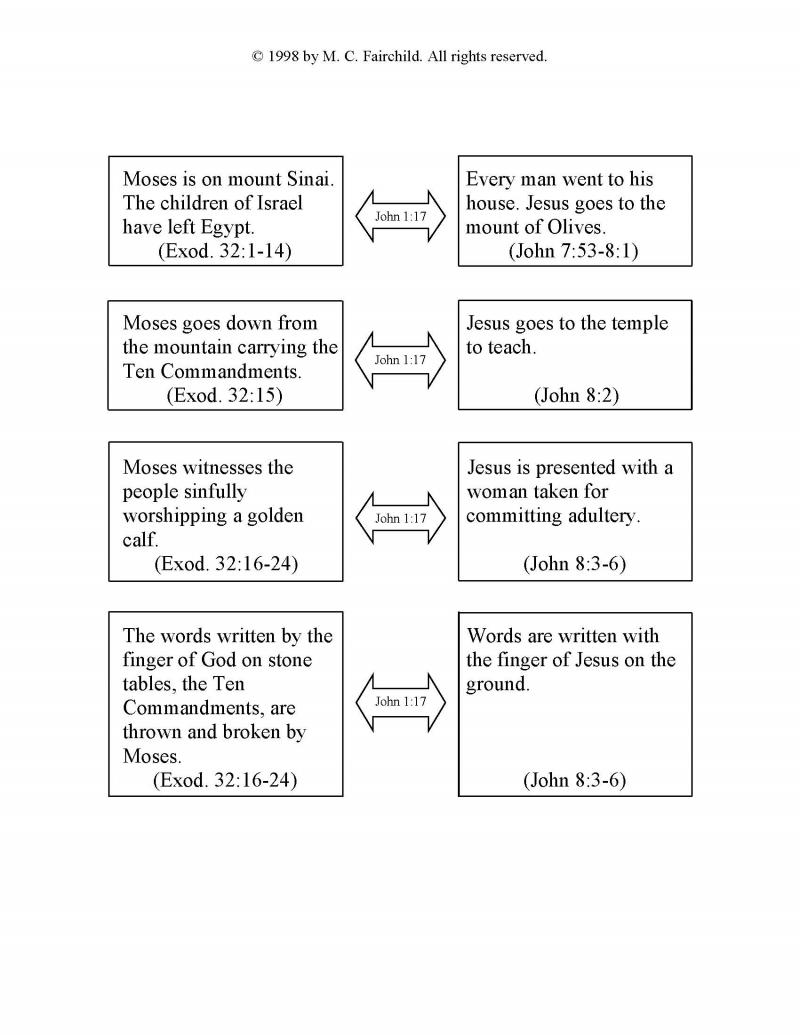

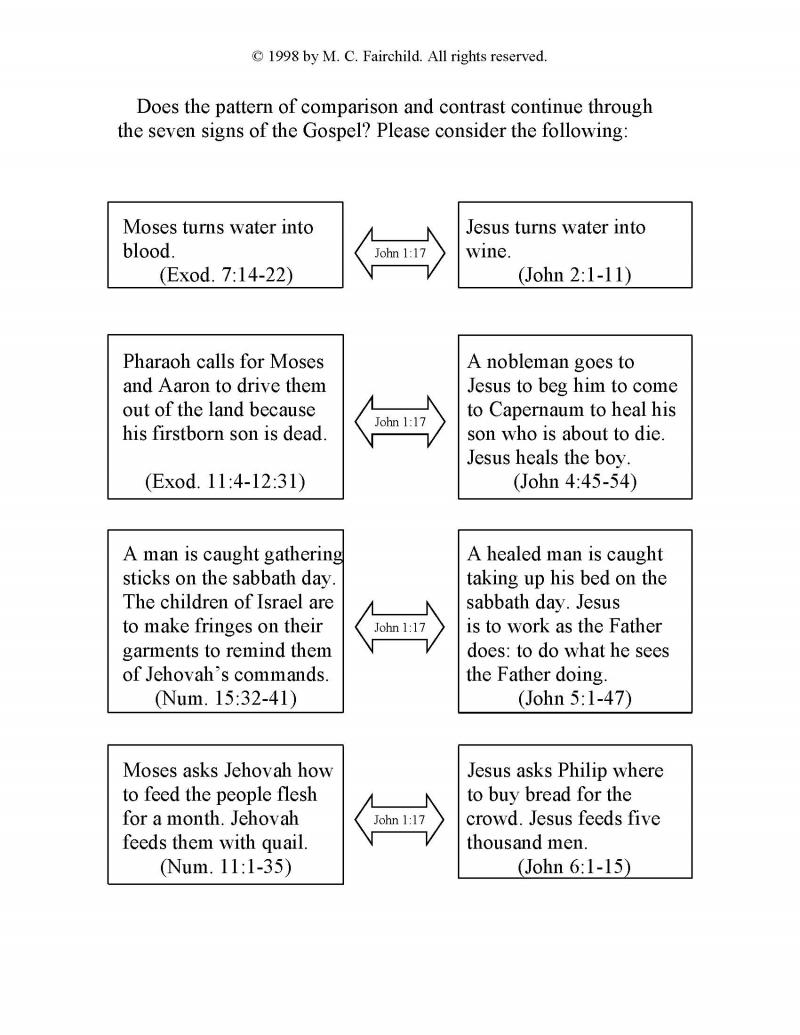


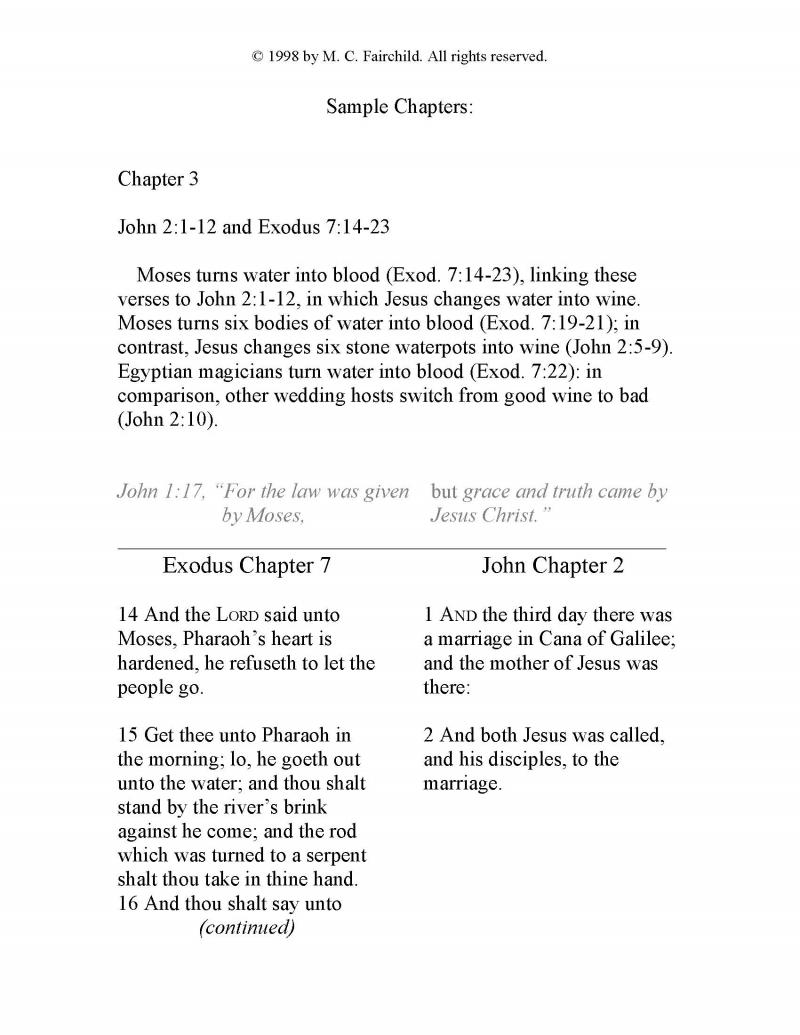
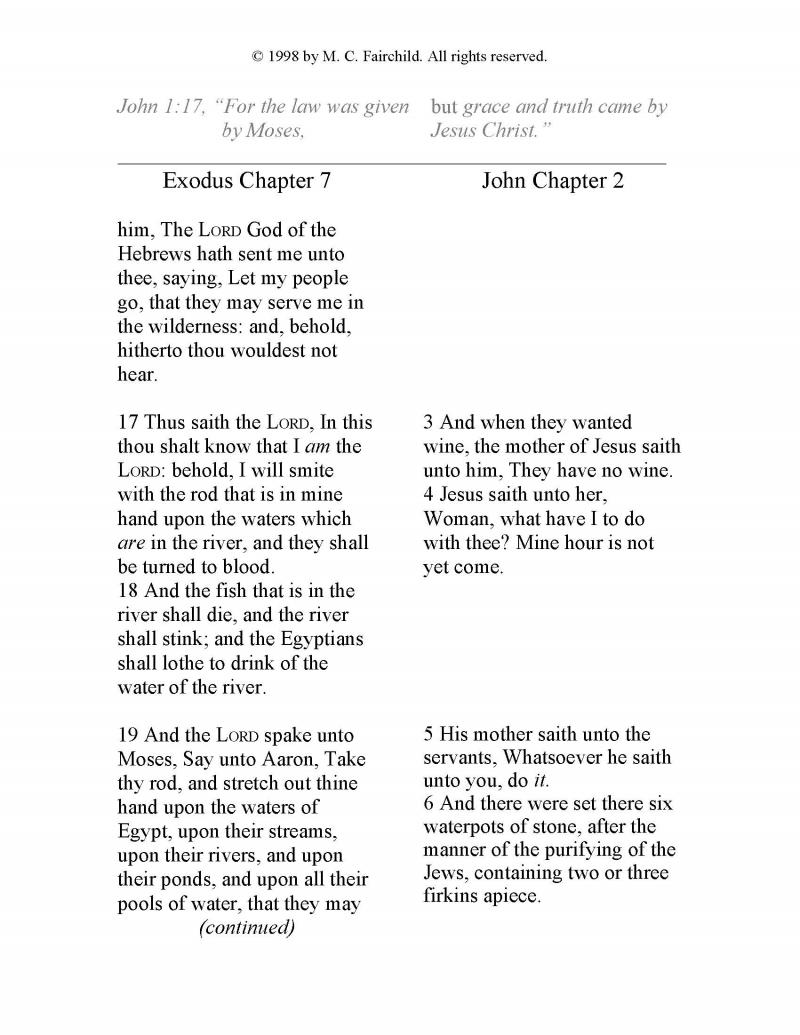
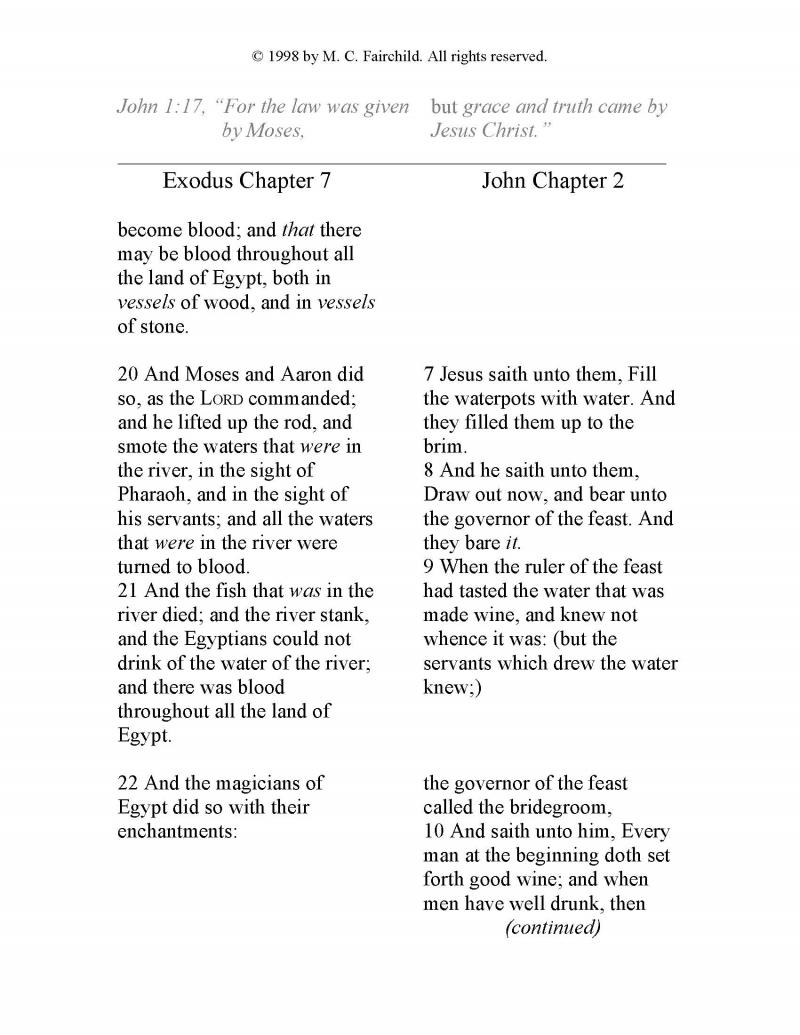

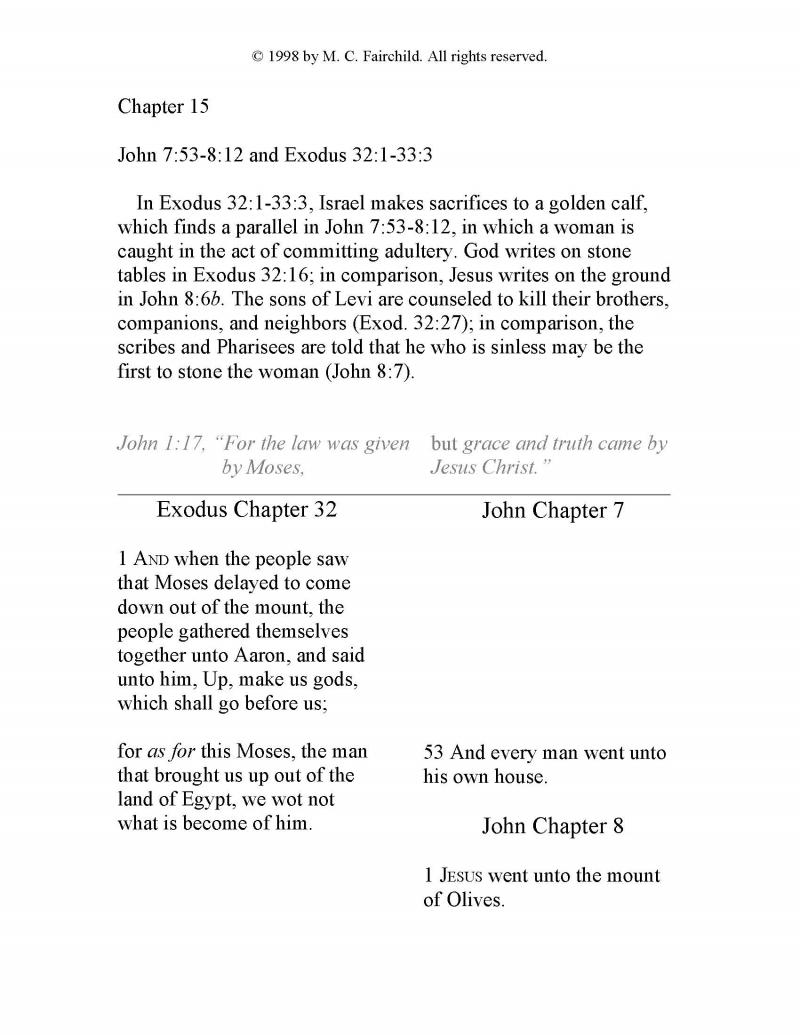


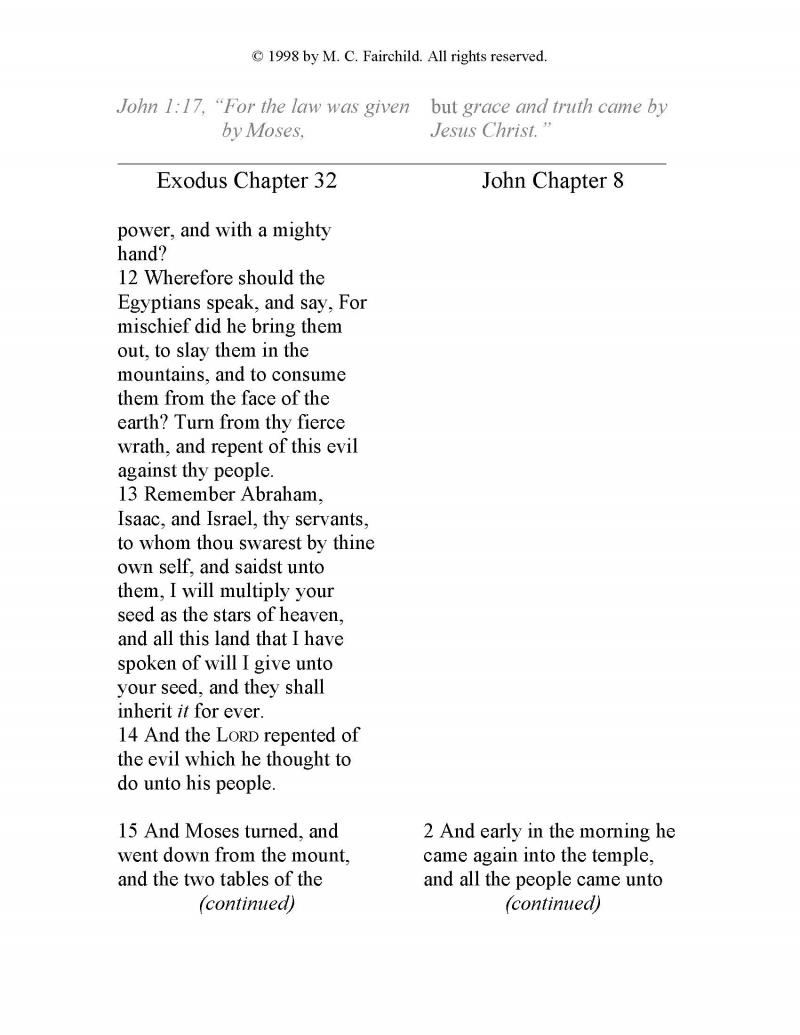
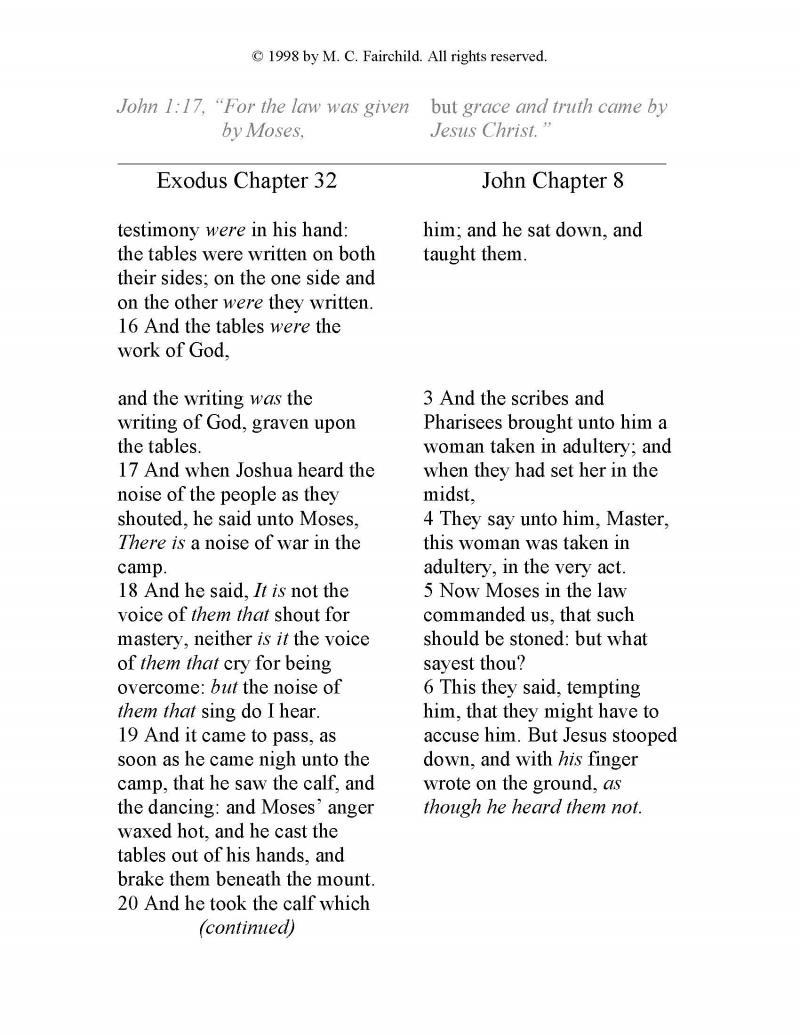
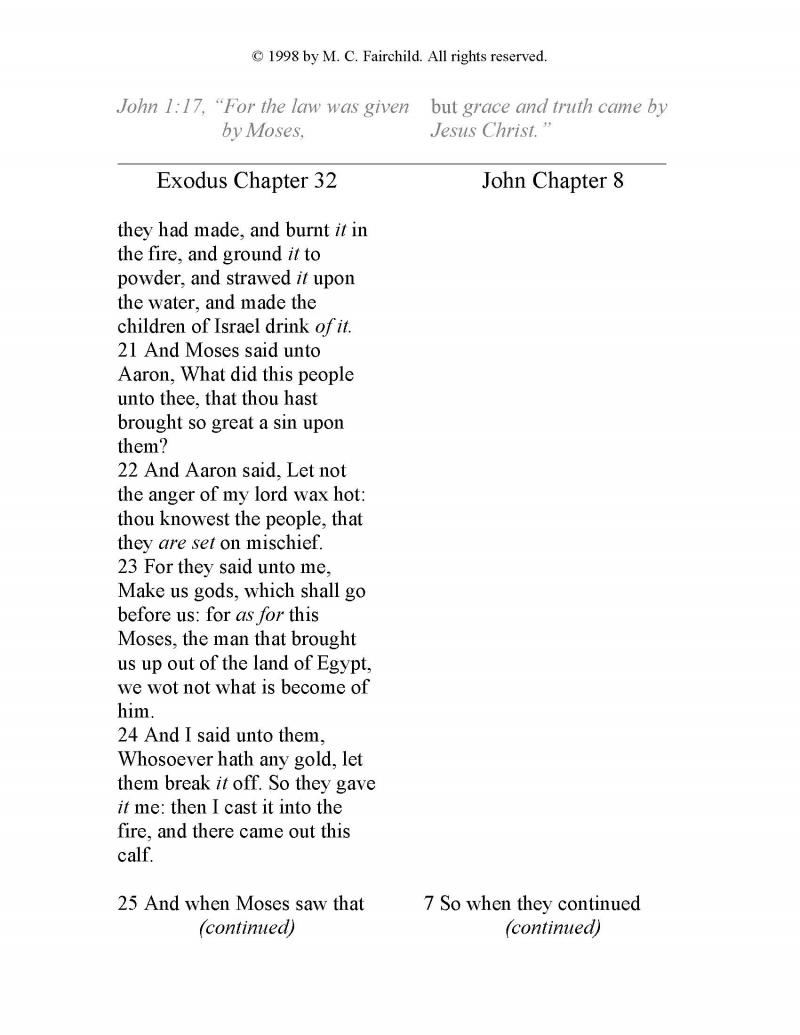

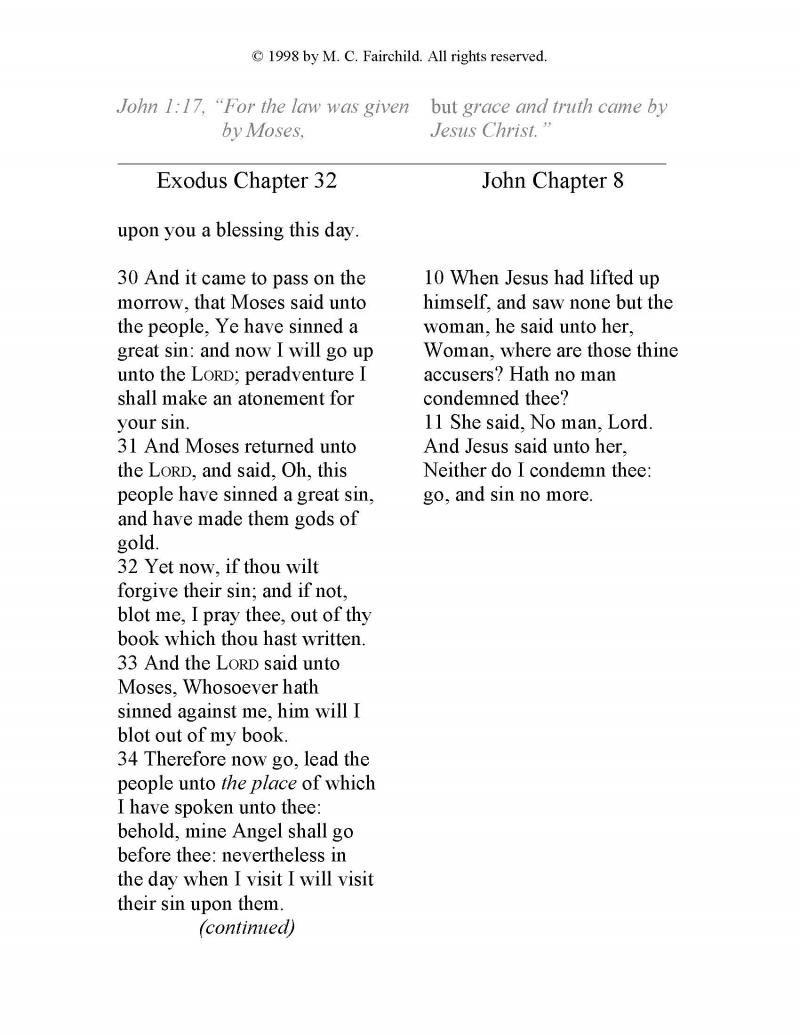
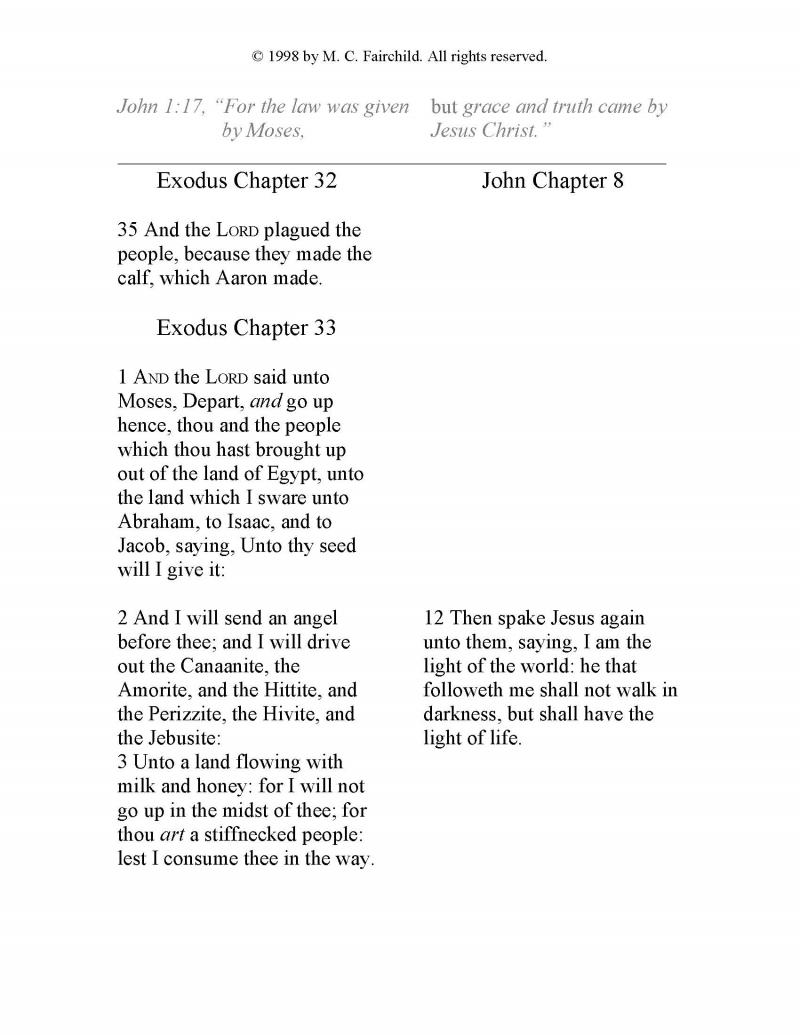

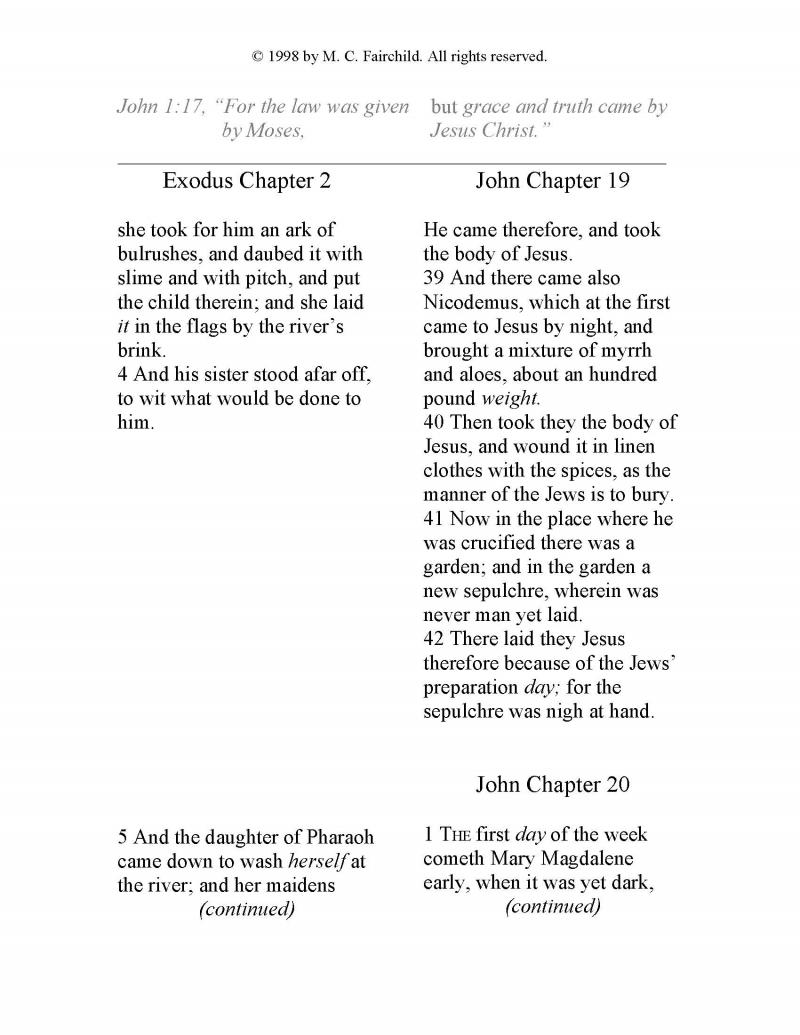


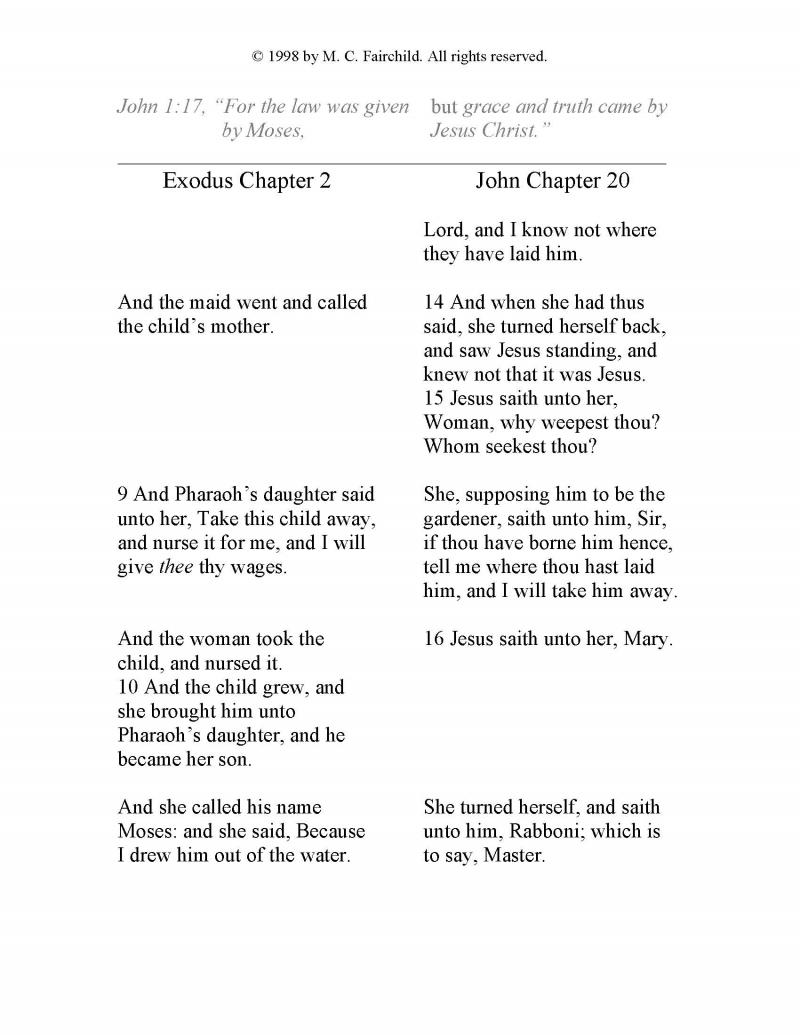



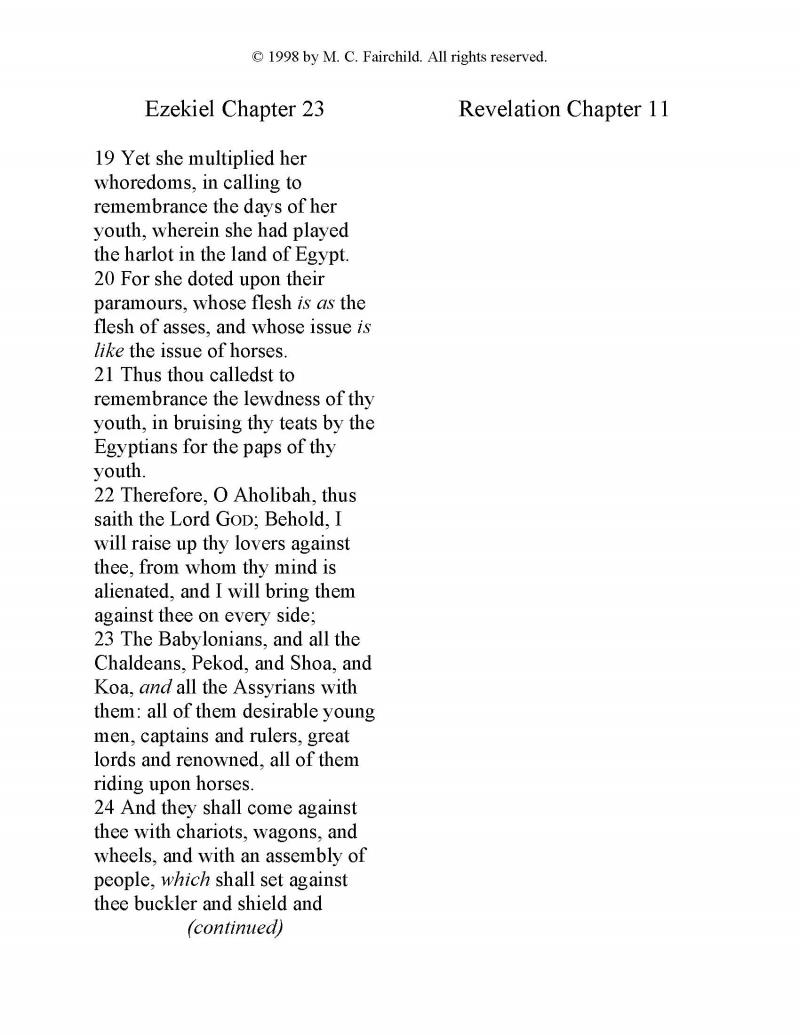
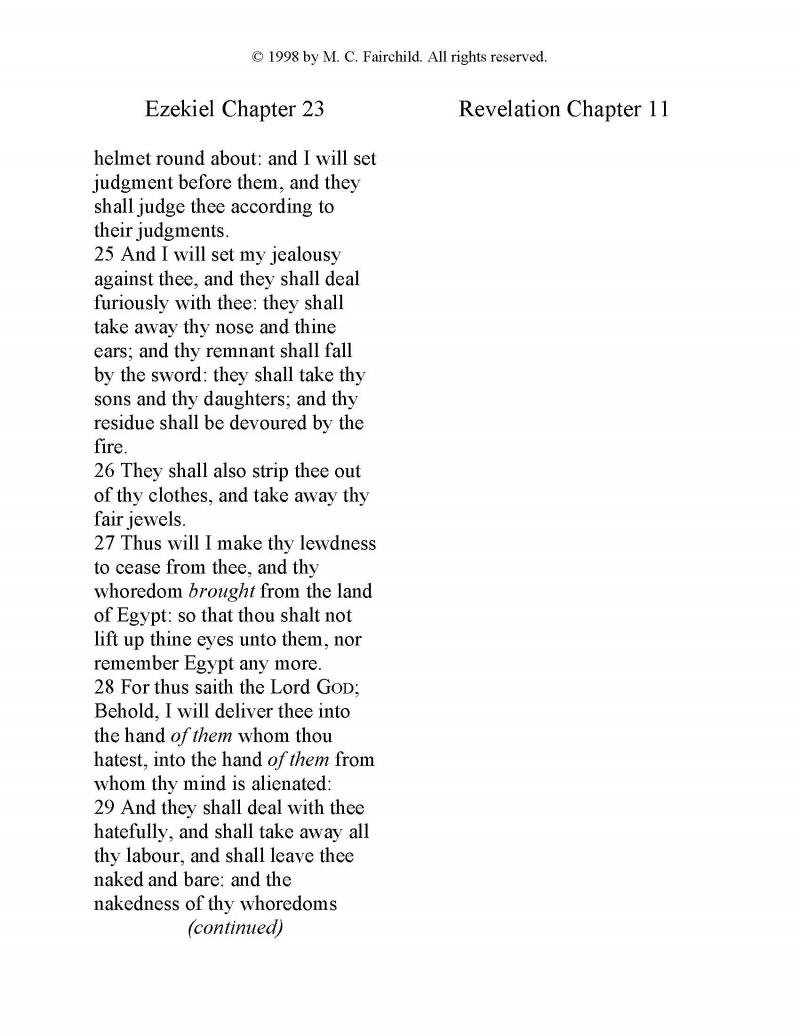


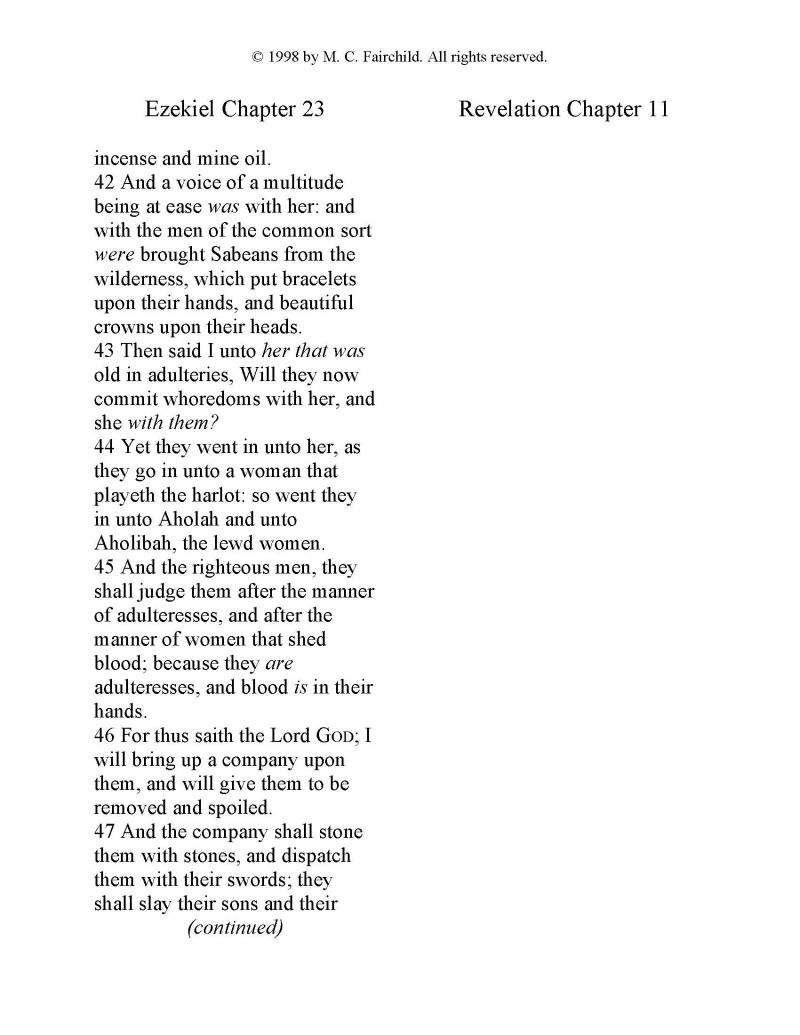
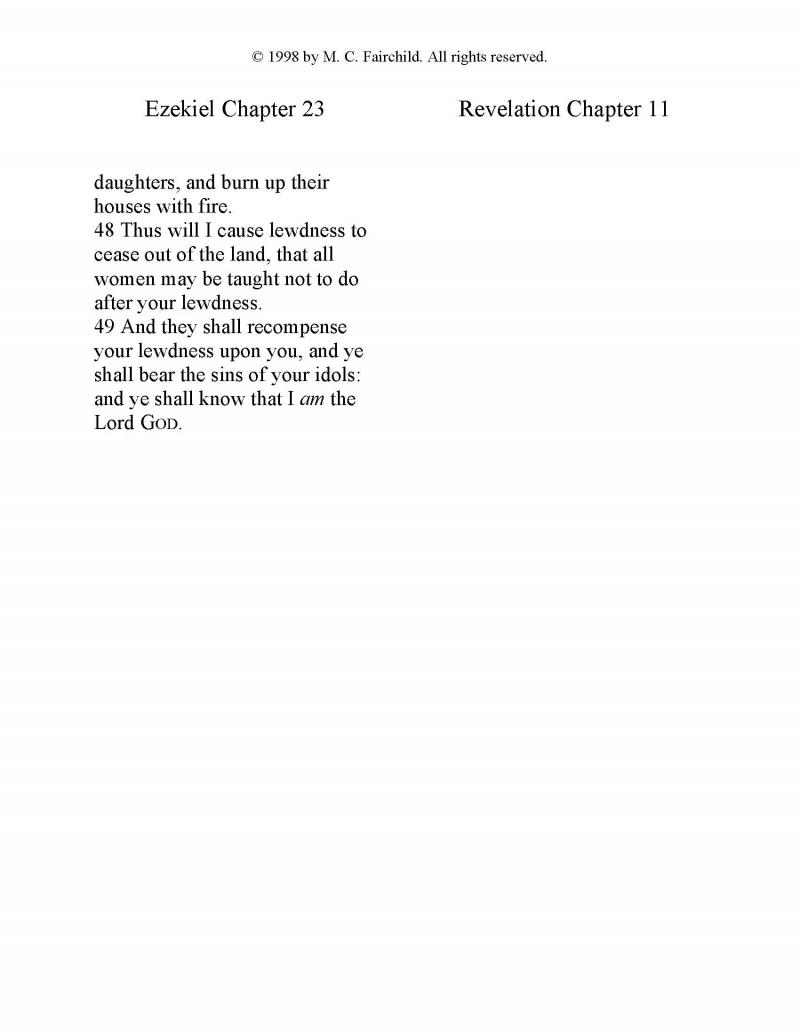

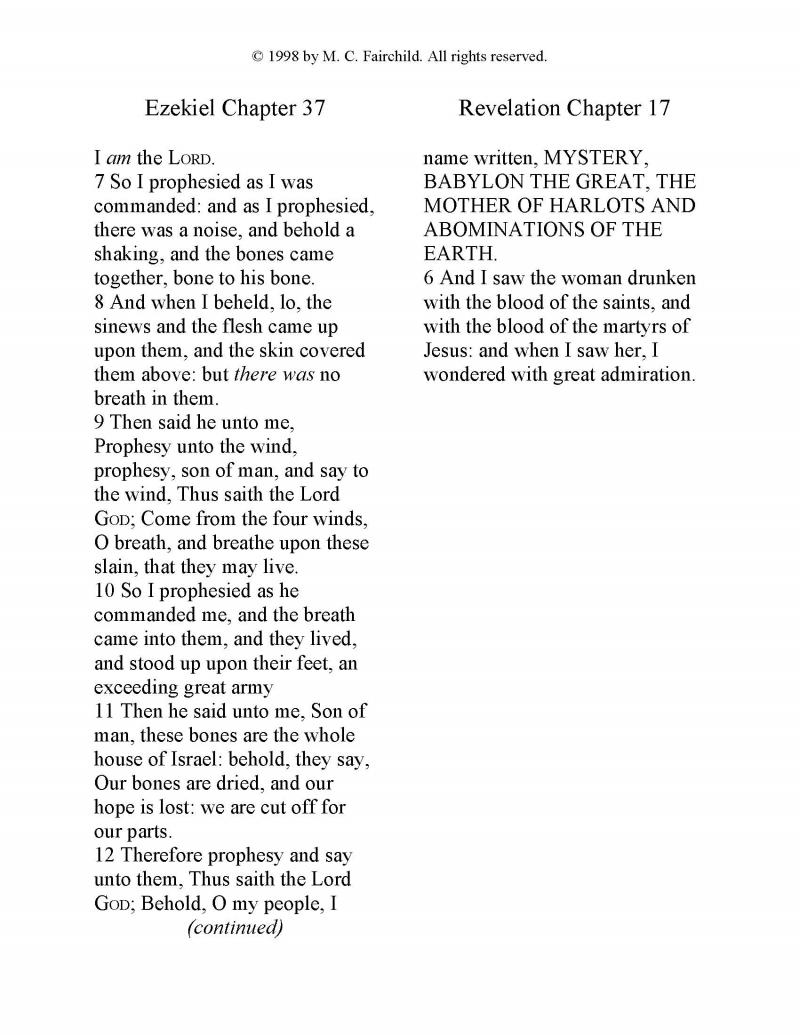
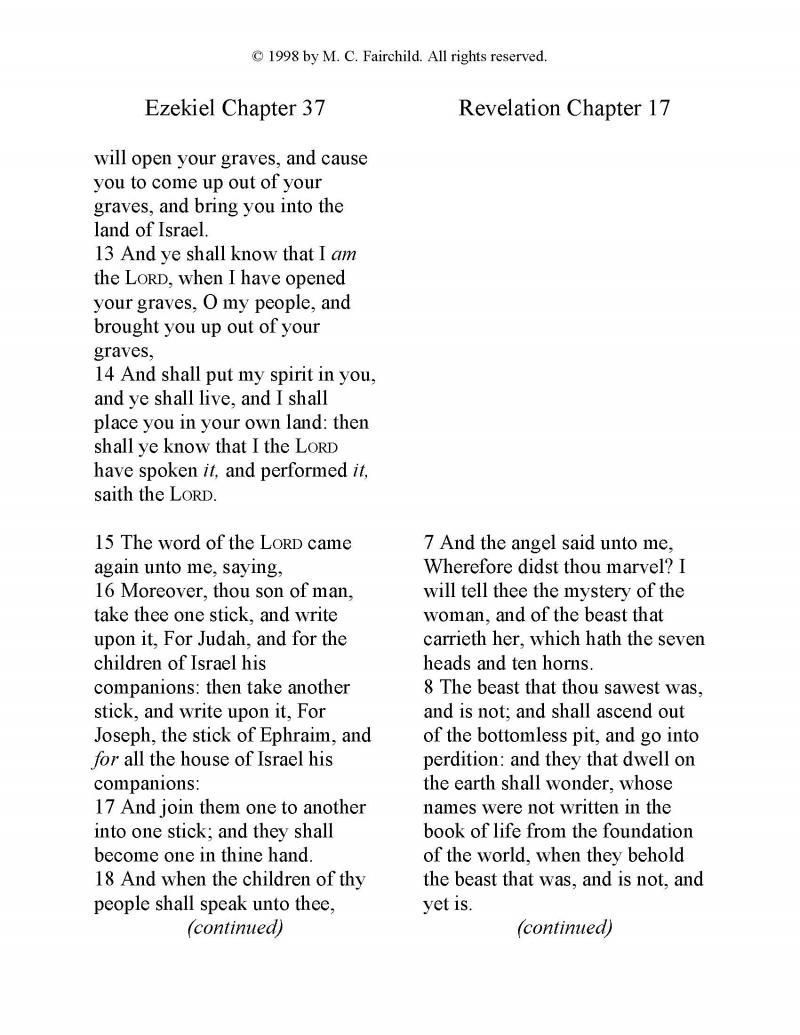




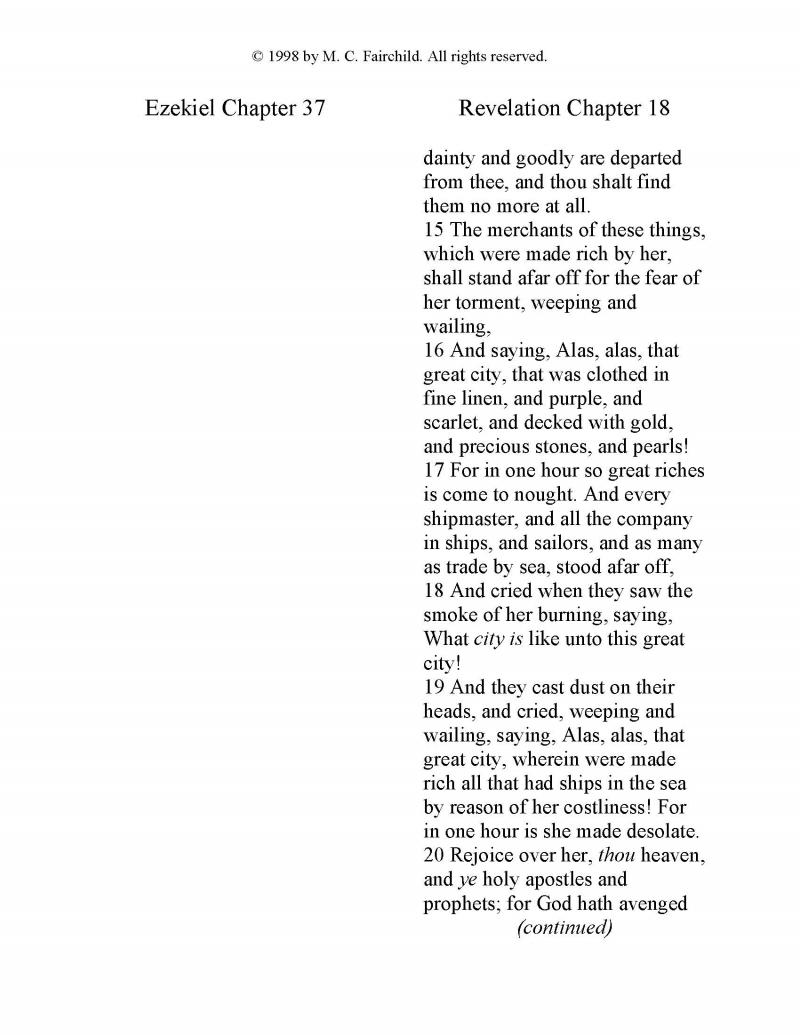
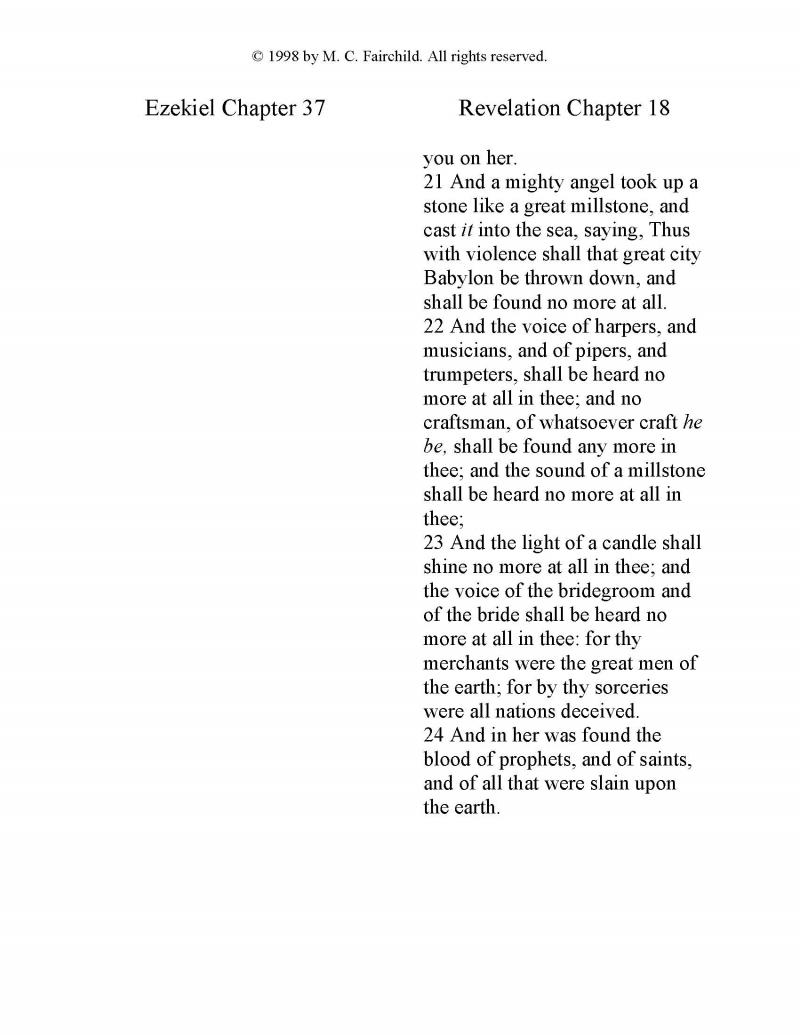
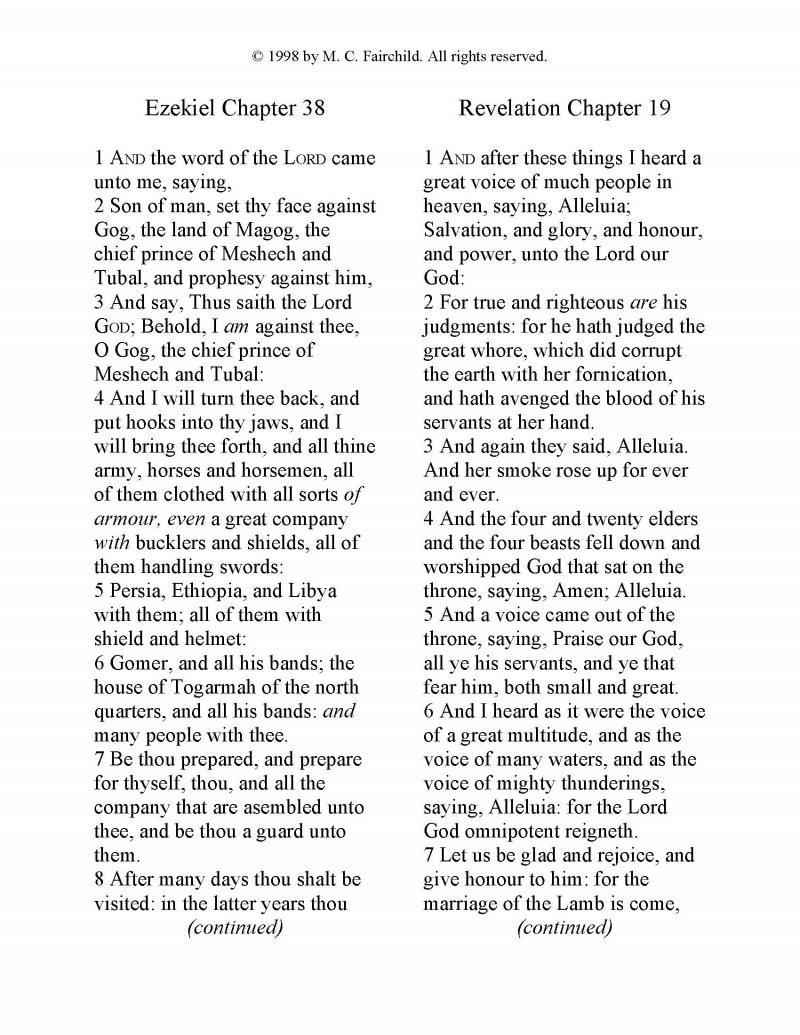

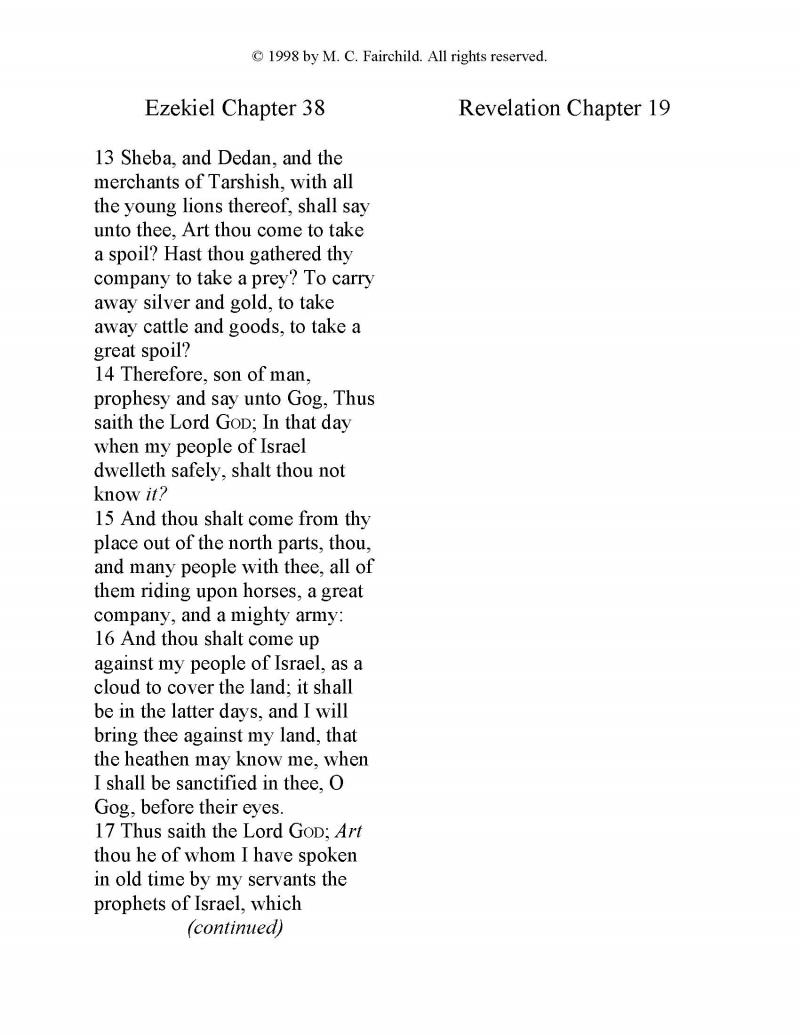
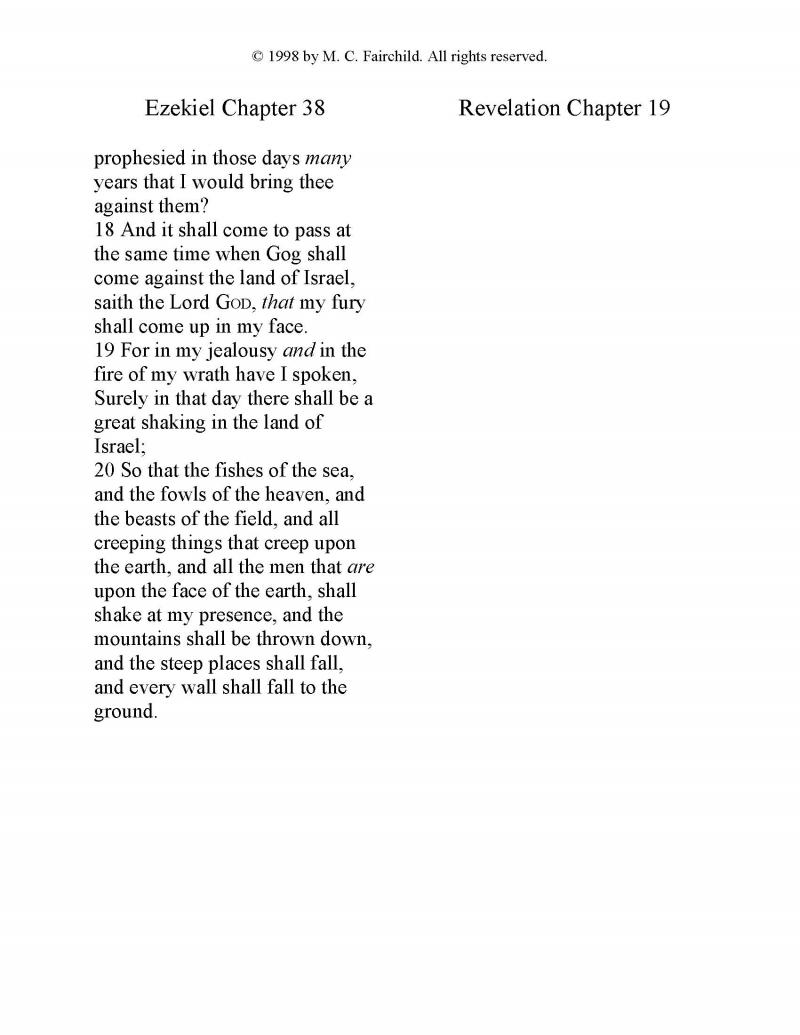
Please consider the following paraphrases:
Summary
Chapter 1
John 1:1-18 and Exodus 19:1-25
A connection is made between Jehovah revealing himself to the house of Jacob and the children of Israel in a thick cloud on mount Sinai (Exod. 19:1-25) and Jesus, the Word and true Light, coming into the world (John 1:1-18). All the earth is Jehovah's (Exod. 19:5); in comparison, "All things were made by him [the Word]" (John 1:3). In obedience to Jehovah is a peculiar treasure and a kingdom of priests (Exod. 19:5-6); in comparison, in the Word is life, the light of men (John 1:4). Elders are summoned to witness the words of Jehovah that are laid before them (Exod. 19:7); in comparison, John is sent from God as a witness to the Light (John 1:6-7). Exodus 19:9 reads, "Lo, I come unto thee in a thick cloud"; in contrast, Jesus is the true Light (John 1:9). The people are to be sanctified (Exod. 19:10); in comparison, sons of God receive Jesus and believe on his name (John 1:12).
Chapter 2
John 1:19-51 and Exodus 33:1-34:10
A link is uncovered between Moses being shown Jehovah's glory (Exod. 33:1-34:10) and Jesus being revealed to the Jews, priests, Levites, and disciples beginning with the record of John (John 1:19-51). The people witness the cloudy pillar descend and stand at the tabernacle door while Jehovah speaks with Moses (Exod. 33:9); in comparison, John's record states, "I saw the Spirit descending from heaven like a dove, and it abode upon him [Jesus]" (John 1:32). Jehovah covenants to "do marvels, such as have not been done in all the earth, nor in any nation" (Exod. 34:10a); in comparison, Jesus promises Nathanael that he will "see heaven open, and the angels of God ascending and descending upon the Son of man" (John 1:51).
Chapter 3
John 2:1-12 and Exodus 7:14-23
Moses turns water into blood (Exod. 7:14-23), linking these verses to John 2:1-12, in which Jesus changes water into wine. Moses turns six bodies of water into blood (Exod. 7:19-21); in contrast, Jesus changes six stone waterpots into wine (John 2:5-9). Egyptian magicians turn water into blood (Exod. 7:22); in comparison, other wedding hosts switch from good wine to bad (John 2:10).
Chapter 4
John 2:13-25 and Leviticus 24:10-23
A link is formed between the son of an Israelitish woman striving and blaspheming in Leviticus 24:10-23 and Jesus driving merchants out of the temple while saying, "Make not my Father's house an house of merchandise" (John 2:13-25). The children of Israel put the man "in ward, that the mind of the LORD might be shewed them" (Lev. 24:12); in comparison, the Jews seek a sign of Jesus' authority (John 2:18). In Leviticus 24:14, the blasphemer is to be stoned; in comparison, Jesus says, "Destroy this temple" (John 2:19).
Chapter 5
John 3:1-21 and Numbers 10:29-36
In Numbers 10:29-36, Moses asks his brother-in-law to lead the children of Israel through the wilderness, revealing a parallel with John 3:1-21, in which Jesus teaches Nicodemus that the Spirit guides its children like the wind blowing and as light in darkness. Hobab will go to his own land and own kindred (Num. 10:30); in comparison, for Nicodemus to see the kingdom of God, he must be born again (John 3:3). In Numbers 10:34, the cloud of Jehovah is to lead the children of Israel; in comparison, God's Son is to save the world (John 3:17).
Chapter 6
John 3:22-4:3 and Exodus 15:22-27
A link is made between Moses throwing a tree into the waters of Marah to heal the waters (Exod. 15:22-27) and Jesus' disciples baptizing the people (John 3:22-4:3). The people murmur about what to drink (Exod. 15:24); in comparison, the Jews question John's disciples about purification (John 3:25). Keeping Jehovah's statutes delivers from diseases (Exod. 15:26); in comparison, believing on the Son brings everlasting life (John 3:36).
Chapter 7
John 4:1-44, Exodus 2:13-22, and Numbers 12:1-16
Miriam speaks against the authority of Moses (Num. 12:1-16), linking this account to that of a Samaritan woman who believes that Jesus is a prophet, even the Messiah (John 4:1-44). Moses meets his future wife at a well (Exod. 2:15b-16); in comparison, Jesus meets a Samaritan woman at a well (John 4:6-7). Miriam and Aaron speak against Moses because he married an Ethiopian woman (Num. 12:1); in comparison, the Samaritan woman questions Jesus because he spoke to a foreigner (John 4:9). Is Moses greater than Miriam and Aaron? (Num. 12:2); similarly, is Jesus greater than Jacob? (John 4:12). Moses speaks with Jehovah and sees his similitude (Num. 12:8); in comparison, the Samaritan woman speaks to the Messiah (John 4:25-26).
Chapter 8
John 4:45-54, Exodus 12:25-31, and Exodus 11:1-10
A link is made between Pharaoh calling for Moses, intending to thrust him out of the land because Pharaoh's firstborn son is dead (Exod. 12:25-31, and 11:1-10) and a nobleman going to Jesus to beg that he would come to Capernaum and heal his son who was at the point of death (John 4:45-54). The children of Israel are promised to witness the passover sacrifice (Exod. 12:26-27); in comparison, the Galilaeans see all things that Jesus did at the passover feast in Jerusalem (John 4:45). Pharaoh believes Moses and tells the children of Israel to leave because the Egyptian firstborn are dead (Exod. 12:31); in comparison, the people must see signs and wonders to believe (John 4:48).
Chapter 9
John 5:1-47 and Numbers 15:32-41
A link is shown between a man gathering sticks on the sabbath day in Numbers 15:32-41 and a healed man carrying his bed on the sabbath day in John 5:1-47. The children of Israel are told to make fringes in the borders of their garments as a reminder to do Jehovah's commandments (Num. 15:38-39); in comparison, Jesus is to work as the Father does, to do what he sees the Father doing (John 5:17-21). Jehovah testifies, "I am the LORD your God, which brought you out of the land of Egypt, to be your God" (Num. 15:41); in comparison, the Father bears witness concerning Jesus (John 5:37a).
Chapter 10
John 6:1-15 and Numbers 11:1-35
Jehovah feeds the people with quail in Numbers 11:1-35, just as Jesus feeds a great company with bread and fish in John 6:1-15. Moses asks Jehovah how to feed the people flesh for a month (Num. 11:21-22); in comparison, Jesus asks Philip, "Whence shall we buy bread, that these may eat?" (John 6:5). Jehovah smites the people because they lusted for flesh (Num. 11:33-34); in comparison, Jesus departs because of their desire to forcibly make him king (John 6:15).
Chapter 11
John 6:16-21 and Exodus 14:1-31
A link is discovered between the children of Israel passing through the Red Sea defended by the pillar of the cloud behind them (Exod. 14:1-31) and the disciples going over the Sea of Galilee followed by Jesus walking on the sea (John 6:16-21). In Exodus 14:19, the angel of God and the pillar of the cloud move behind the camp of Israel; in comparison, Jesus stays behind the disciples in John 6:17b. The Red Sea is divided because of a strong wind (Exod. 14:21); in contrast, The Sea of Galilee is aroused because of a great wind (John 6:18).
Chapter 12
John 6:22-71 and Exodus 16:1-17:4
Manna is the bread from heaven (Exod. 16:1-17:4), and Jesus is the true bread from heaven (John 6:22-71). The whole congregation murmurs and are given the sign of the glory of Jehovah (Exod. 16:7); in comparison, the people doubt and ask for a sign (John 6:30). A portion of manna is put on display in front of the Testimony (Exod. 16:34); in comparison, Jesus is in the synagogue in Capernaum teaching about the true bread—the bread of life (John 6:59).
Chapter 13
Supplemental Interpretation:
John 6:22-29 and Exodus 14:5-14
A link is discovered between Pharaoh pursuing the children of Israel to the Red Sea (Exod. 14:5-14) and the people following Jesus to Capernaum (John 6:22-29). The children of Israel ask Moses why he carried them out of Egypt in Exodus 14:11; similarly, in John 6:25, the people ask Jesus, "Rabbi, when camest thou hither?" In Exodus 14:13, Jehovah condemns the Egyptians; in contrast, the Father seals the Son of man with approval (John 6:27).
Chapter 14
John 7:1-52 and Numbers 16:1-50
The rebellion of Korah, Dathan, Abiram, and On, which takes place after the congregation is sent to wander in the wilderness 40 years (Num. 16:1-50), is linked to the unbelief of Jesus' brethren before the feast of tabernacles (John 7:1-52). The rebels state to Moses and Aaron, "all the congregation are holy" and that Moses and Aaron lift themselves up (Num. 16:3); in contrast, Jesus tells his brothers that the time is always at hand for them to approach the temple, but his time has not yet come (John 7:6). In Numbers 16:30, the rebels are to go down to the pit; in contrast, Jesus is to go where the Jews cannot (John 7:34). A stranger is not to approach Jehovah to offer incense lest fire come out from Jehovah and consume the stranger (Num. 16:35-40); in contrast, whoever believes on Jesus is to come to him, and rivers of living water will come from within that person—the Spirit (John 7:37-39).
Chapter 15
John 7:53-8:12 and Exodus 32:1-33:3
In Exodus 32:1-33:3, Israel makes sacrifices to a golden calf, which finds a parallel in John 7:53-8:12, in which a woman is caught in the act of committing adultery. God writes on stone tables in Exodus 32:16; in comparison, Jesus writes on the ground in John 8:6b. The sons of Levi are counseled to kill their brothers, companions, and neighbors (Exod. 32:27); in comparison, the scribes and Pharisees are told that he who is sinless may be the first to stone the woman (John 8:7).
Chapter 16
John 8:12-59 and Exodus 24-29
A parallel is made between physical objects (the tabernacle, the ark of the testimony, the table, the candlestick, and the altar) as the representation of God's presence among the children of Israel (Exod. 24-29) and Jesus' words as the new embodiment of God's presence (John 8:12-59). God is seen in the mountain by Nadab, Abihu, and 70 of the elders, but God does not stretch out his hand against them (Exod. 24:9-11); similarly, Jesus is seen teaching in the temple and no man lays hands on him (John 8:20). In Exodus 24:12, Moses is to ascend the mountain to receive tables of stone and commandments to be taught; in comparison, in John 8:28, the Son of man is to be lifted up to reveal that he has spoken what the Father taught. Lastly, Aaron's holy garments give glory and beauty (Exod. 28:2); in comparison, the Father gives Jesus honour (John 8:54).
Chapter 17
John 9:1-41 and Exodus 32:30-34:10
A link is found between Moses seeing Jehovah's glory, although no man may see Jehovah's face and live (Exod. 32:30-34:10), and the account of a man who is blind from birth seeing the Son of God (John 9:1-41). In Exodus 34:10, Jehovah says he will do marvels, and the people among whom the children of Israel live will see the terrible work he will do; in comparison, Jesus says he will do judgment, that "they which see not might see; and they which see might be made blind" (John 9:39).
Chapter 18
John 10:1-22a and Exodus 34:11-35:11
The following accounts share a link: Moses receives the second set of the Ten Commandments (Exod. 34:11-35:11) and Jesus, the good shepherd, receives the commandment that he has authority to lay down his life and to take it again (John 10:1-22a). In Exodus 34:14, the children of Israel are counseled not to worship any other God; in comparison, the Jews are to follow the voice of the shepherd in John 10:3-4. The children of Israel are to redeem their firstborn sons in Exodus 34:20; in comparison, the good shepherd is to give his life for the sheep in John 10:11. The children of Israel are not to leave the sacrifice of the feast of the passover until morning (Exod. 34:25); similarly, Jesus is to take his life again (John 10:17).
Chapter 19
John 10:22b-42 and Numbers 13:16-14:43
A link is discovered between all the congregation of the children of Israel witnessing the fruit of the land of Canaan only to reject entering the land (Num. 13:16-14:43) and the Jews witnessing the works of Jesus only to refuse eternal life (John 10:22b-42). Ten spies incite all the congregation to overthrow Moses (Num. 13:31-14:4); in comparison, the Jews seek to stone Jesus (John 10:31). Caleb and Joshua believe Jehovah's promise, and they will enter the land (Num. 14:30); in comparison, those who hear the word of God will be called gods (John 10:34-35).
Chapter 20
John 11:1-57, Deuteronomy 32:48-52, Numbers 20:1-13, and Numbers 27:12-23
There is a parallel between the account of Moses being condemned to die outside of the land of Canaan (Deut. 32:48-52, Num. 20:1-13, and Num. 27:12-23) and Lazarus being raised from the dead (John 11:1-57). Moses, Aaron, and the congregation gather before a rock (Num. 20:10); in comparison, Jesus, Martha, Mary, and the Jews gather before a cave with a stone lying on it (John 11:33-38). Moses disbelieves Jehovah by smiting the rock twice with his rod instead of speaking to it (Num. 20:11); in contrast, Jesus honors God by speaking twice: "Father, I thank thee" and "Lazarus, come forth" (John 11:41-43).
Chapter 21
John 12:1-8 and Numbers 25:1-11
The account of the daughters of Moab enticing the people to sacrifice to their gods and commit whoredom (Num. 25:1-11) can be contrasted with the account of Mary anointing the feet of Jesus (John 12:1-8). In Numbers 25:4-5, the dead bodies of the idolatrous leaders are to be displayed; in contrast, Lazarus, who was raised from the dead, is seen at a supper given in Jesus' honor (John 12:2b). Phinehas was zealous for Jehovah's honor (Num. 25:11); in comparison, Mary was zealous for Jesus' honor (John 12:7).
Chapter 22
John 12:9-19 and Numbers 17:1-13
A link is made between Jehovah honoring the tribe of Levi, causing Aaron's rod to blossom (Num. 17:1-13), and the people honoring Jesus, causing them to carry palm branches and cry, "Hosanna" and "The King of Israel" (John 12:9-19). The children of Israel murmur, provoking Jehovah to provide a sign (Num. 17:5); in comparison, the chief priests plot murder responding to the miraculous sign of Lazarus' resurrection (John 12:10). In Numbers 17:13, the children of Israel fear to approach the tabernacle of Jehovah: "Whosoever cometh any thing near unto the tabernacle of the LORD shall die"; in contrast, the people go to meet Jesus: "The world is gone after him" (John 12:17-19).
Chapter 23
John 12:14-33 and Exodus 17:8-16
There is a parallel between the Amalekites fighting against Israel (Exod. 17:8-16) and the Greeks desiring to see Jesus (John 12:14-33). In Exodus 17:10, Aaron and Hur assist Moses; in comparison, Philip and Andrew advise Jesus in John 12:22. Jehovah will "utterly put out the remembrance of Amalek from under heaven" (Exod. 17:14); in comparison, "now shall the prince of this world be cast out" (John 12:31).
Chapter 24
John 12:34-50 and Exodus 34:27-35
A link is formed between the children of Israel seeing Moses' face shine (Exod. 34:27-35) and Isaiah seeing Jesus' glory and speaking of him (John 12:34-50). Talking with Jehovah makes the skin of Moses' face shine (Exod. 34:29); in comparison, Jesus is light, and walking in the light makes people the children of light (John 12:35-36). In Exodus 34:32, Moses gives all the children of Israel the commandments that he heard from Jehovah on mount Sinai; in comparison, Jesus says that he who believes on him believes on the one who sent him (John 12:44).
Chapter 25
John 13:1-35 and Exodus 2:10-4:18
A link is formed between the angel of Jehovah appearing to Moses in a flame of fire out of a bush (Exod. 2:10-4:18) and Jesus showing himself to the disciples girded with a towel (John 13:1-35). When Moses was grown, he slew an Egyptian (Exod. 2:11-12); in comparison, just before the feast of the passover, Jesus' hour was come (John 13:1). In Exodus 3:5, Moses is to remove his shoes; similarly, Jesus washes the feet of the disciples (John 13:5). Moses is given three signs so that the children of Israel will believe that Jehovah appeared to him (Exod. 4:1-9); in comparison, the disciples are told three times that Jesus will be betrayed, so that when it happens, they will believe that Jesus is the Master and Lord (John 13:10b-29). In Exodus 4:13, Moses asks that someone else be sent; in contrast, Judas goes when sent (John 13:30).
Chapter 26
John 13:36-38 and Numbers 22:1-31
A parallel is illuminated between Balaam smiting his ass three times (Num. 22:1-31) and Simon Peter's predicted denial of Jesus three times (John 13:36-38). The ass speaks to reprove Balaam (Num. 22:28); in comparison, the cock will crow to reprove Simon Peter (John 13:38b).
Chapter 27
John 14:1-31, Genesis 15:1-21, and Genesis 50:24-Exodus 1:8
A link is made between the account of Jehovah's promise to Abram of an heir, offspring to be numbered like the stars, land for them, and great substance from Egypt (Gen. 15:1-21) and Jesus' promise of many mansions in the Father's house, the Spirit of truth, co-habitation with the Father and the Son, and peace (John 14:1-31). Jehovah is set to show himself to Abram's offspring in the form of a smoking furnace and a burning lamp (Gen. 15:17) or a pillar of cloud and a pillar of fire (see Exod. 13:21); in comparison, Jesus will manifest himself to those who love him (John 14:21). Joseph promises that God will visit the children of Israel (Gen. 50:24-Exod. 1:8); in comparison, Jesus promises that the Comforter, the Holy Ghost, will come (John 14:25-31).
Chapter 28
John 15:1-27 and Numbers 13:16-14:9
A link is revealed between Moses' spies reporting on the fruit and dangers of the land of Canaan (Num. 13:16-14:9) and Jesus reporting on his fruit—fullness of joy and love for one another—and the hatred of the world (John 15:1-27). Moses is persecuted for delivering the congregation from Egypt in Numbers 14:3; in comparison, disciples will be persecuted like their Lord was (John 15:20). Joshua and Caleb speak about the land of Canaan (Num. 14:6-9); in comparison, the Spirit of truth will testify about Jesus (John 15:26-27).
Chapter 29
John 16:1-33 and Numbers 14:10-45
A link can be found between Jehovah condemning the children of Israel to die for refusing to enter the land he swore to the fathers (Num. 14:10-45) and the Comforter reproving the world for not believing Jesus (John 16:1-33). Jehovah's glory will fill the earth (Num. 14:21); in contrast, the Comforter will not come to the disciples unless Jesus goes away (John 16:7). The adults will fall in the wilderness, but after 40 years their children will be brought in to the land their fathers despised (Num. 14:28-32); in comparison, Jesus is going away, but after a little while the disciples will see him (John 16:19b).
Chapter 30
John 17:1-26 and Exodus 3:1-4:18
A link is formed between God sending Moses to deliver the children of Israel out of oppression (Exod. 3:1-4:18) and Jesus finishing his work: to give eternal life to as many as he was given (John 17:1-26). God's name is revealed to Moses (Exod. 3:14); in comparison, the Father's name is manifested by Jesus to those he was given (John 17:6). Jehovah will stretch out his hand and smite the Egyptians (Exod. 3:20); similarly, Jesus will not pray for the world (John 17:9). The people will be favored (Exod. 3:21); in comparison, Jesus prays for those who believe him (John 17:9). Moses is to give three signs (Exod. 4:1-9); in comparison, Jesus fulfills scripture concerning Judas Iscariot, gives joy, and gives truth (John 17:11-17). Moses is to be as God to Aaron (Exod. 4:16); in comparison, the disciples are given the glory of Jesus (John 17:22).
Chapter 31
John 18:1-32 and Exodus 4:19-26
A link is shown between Jehovah seeking to kill Moses when he returned into Egypt (Exod. 4:19-26) and Annas, Caiaphas, and Pharisees seeking to kill Jesus in John 18:1-32. If Pharaoh holds Israel, then Jehovah will slay Pharaoh's son (Exod. 4:22-23); in comparison, Simon Peter smites the high priest's servant and Jesus is arrested (John 18:10-12). Moses did not circumcise his son, which is a broken covenant (Exod. 4:25); similarly, Peter did not acknowledge his Lord, demonstrating a broken fellowship (John 18:17). Jehovah lets Moses go (Exod. 4:26); in contrast, the Jews deliver Jesus to Pilate for crucifixion (John 18:28-32).
Chapter 32
John 18:33-40 and Exodus 18:13-27
A link is formed between Moses judging the children of Israel (Exod. 18:13-27) and Pilate judging Jesus (John 18:33-40). Lesser judges are to pass great matters to higher judges (Exod. 18:21-22); in comparison, the Jews and chief priests passed their case against Jesus to Pilate (John 18:35). Moses' father-in-law departs (Exod. 18:27); in comparison, Barabbas is set free (John 18:40).
Chapter 33
John 18:37-19:37 and Numbers 21:4-9
A link is made between Moses making a serpent on a pole (Num. 21:4-9) and Pilate crucifying Jesus on the cross (John 18:37-19:37). The people grow discouraged (Num. 21:4); in comparison, soldiers mock Jesus (John 19:2-3). The people speak against God and against Moses (Num. 21:5); in comparison, the chief priests and officers cry out, "Crucify him, crucify him" (John 19:6). The serpent of brass on a pole is made so that anyone bitten by a serpent may behold the serpent of brass and live (Num. 21:9); in comparison, Jesus is crucified, and the promise made in scripture, "They shall look on him whom they pierced," is fulfilled (John 19:15-37).
Chapter 34
Supplemental Interpretation:
John 19:12-22 and Deuteronomy 18:15-19
A link is formed between Jehovah raising up a Prophet to Israel (Deut. 18:15-19) and Pilate giving the Jews their King (John 19:12-22). At Horeb the children of Israel ask not to hear again the voice of Jehovah (Deut. 18:16); in comparison, at the Pavement, the Jews ask that Jesus be taken away (John 19:13-15). Jehovah consents to the request of the children of Israel (Deut. 18:17); in comparison, Pilate consents to the request of the Jews (John 19:16a). The Prophet will rise up from among the Israelites' brethren (Deut. 18:18); in comparison, "JESUS OF NAZARETH THE KING OF THE JEWS" is crucified with two others (John 19:16b-21). Jehovah will judge those who do not listen to the Prophet's words (Deut. 18:19); in contrast, Pilate accepts Jesus' claim as Israel's King. (John 19:22).
Chapter 35
Supplemental Interpretation:
John 19:23-27 and Leviticus 18:1-30
A link is made between the laws concerning uncovering the nakedness of mothers, or their sisters (Lev. 18:1-30) and Jesus' nakedness being uncovered to his mother and her sister in John 19:23-27. Keeping Jehovah's statutes gives life (Lev. 18:1-5); in contrast, Roman soldiers crucify Jesus (John 19:23-24). Transgressors are to be cut off from among their people (Lev. 18:24-30); in contrast, Jesus' mother is joined with the beloved disciple (John 19:27b).
Chapter 36
Supplemental Interpretation:
John 19:28-30 and Numbers 6:1-8
A link is made between vinegar of wine being forbidden to a Nazarite in Numbers 6:1-8 and Jesus taking vinegar in John 19:28-30. Numbers 6:6-8 states that a Nazarite may not approach a dead person; in contrast, before going to the dead (see Doctrine and Covenants 183), Jesus takes vinegar (John 19:30).
Chapter 37
Supplemental Interpretation:
John 19:31-37 and Exodus 12:43-51
A connection is made between the ordinance of the passover (Exod. 12:43-51) and the fulfillment of the scripture, "A bone of him shall not be broken" (John 19:31-37). The ordinance of the passover is given in Exodus 12:43; in comparison, preparations are made for the passover in John 19:31. The passover sacrifice is not to be carried outside (Exod. 12:46); in comparison, the bodies should not remain on the cross (John 19:31-34). Exodus 12:46 states that the bones of the sacrifice are not to be broken; in comparison, Jesus' legs are not broken (John 19:31-34). In Exodus 12:47, all the congregation of Israel is to celebrate the sacrifice; similarly, the disciple whom Jesus loved witnessed his death in John 19:35. Exodus 12:48-49 states that males must be circumcised; in comparison, you may also believe (John 19:35). All of the children of Israel did what Jehovah commanded (Exod. 12:50); in comparison, the scripture, "They shall look on him whom they pierced" is fulfilled in John 19:36-37.
Chapter 38
John 19:38-20:16 and Exodus 2:1-10
A link is made between baby Moses being placed into an ark by the brink of the Nile river (Exod. 2:1-10) and the body of Jesus being placed into a garden sepulchre (John 19:38-20:16). A maid of Pharaoh's daughter is sent to fetch the ark (Exod. 2:5); similarly, two disciples go to inspect the empty sepulchre at Mary's report (John 20:2-3). Pharaoh's daughter calls the child "Moses" (Exod. 2:10b); in comparison, Mary calls Jesus "Rabboni" (John 20:16b).
Chapter 39
Supplemental Interpretation:
John 20:8-20 and Exodus 19:12-20:23
A parallel is formed between the signs of the thunder, the lightning, the thick cloud on the mountain, and the sound of a trumpet (Exod. 19:12-20:23) and the sign of the empty sepulchre and the risen Lord (John 20:8-20). God has come to prove the people (Exod. 20:20); in comparison, Jesus and angels come and question Mary (John 20:11-15). God is to be feared (Exod. 20:20); in comparison, Jesus is to be regarded as "Master" (John 20:16). Moses approaches the thick darkness where God was (Exod. 20:21); in comparison, Jesus is ascending to his Father (John 20:17).
Chapter 40
John 20:19-21:14 and Exodus 6:28-7:24
A link is made between Moses appearing to Pharaoh to perform signs and wonders (Exod. 6:28-7:24) and Jesus appearing to the disciples to perform signs (John 20:19-21:14). Aaron's rod becomes a serpent (Exod. 7:10); in contrast, a crucified Jesus becomes Thomas' God (John 20:27-28). Moses is to meet Pharaoh by the brink of the river (Exod. 7:15); in comparison, the disciples are met by Jesus on the shore of the sea of Tiberias (John 21:4). The sign kills the fish in the river (Exod. 7:17-18); in contrast, at Jesus' direction, the disciples catch fish (John 21:6).
Chapter 41
Supplemental Interpretation:
John 20:21-23 and Leviticus 10:1-3
A parallel exists between the sons of Aaron acting without Jehovah's command resulting in fire coming from him (Lev. 10:1-3) and the disciples being sent by Jesus resulting in the Holy Ghost coming from him (John 20:21-23).
Chapter 42
Supplemental Interpretation:
John 20:24-31 and Leviticus 14:21-32
There is a link between the cleansing of a poor leper (Lev. 14:21-32) and the changing of Thomas from faithless to believing (John 20:24-31). To be cleansed, the poor leper must offer a lamb, offer turtledoves, and perform other ceremonies (Lev. 14:21-22); in comparison, to be changed, Thomas must put his finger into Jesus' nail-printed hands and thrust his hand into his side (John 20:24-25). The law has been given to cleanse a poor leper (Lev. 14:32); in comparison, the signs have been written to give life to those who will believe (John 20:31).
Chapter 43
Supplemental Interpretation:
John 21:1-14 and Exodus 5:1-23
A link is made between the children of Israel desiring a feast to Jehovah in the wilderness (Exod. 5:1-23) and Jesus supplying a meal for the disciples (John 21:1-14). The people get no straw from Pharaoh (Exod. 5:10-11); in comparison, the disciples catch no fish (John 21:3). In Exodus 5:19-20, Moses and Aaron meet distraught officers of the children of Israel; similarly, the disciple whom Jesus loved reveals Jesus to Simon Peter (John 21:7).
Chapter 44
John 21:15-25 and Numbers 20:14-29
A link is made between the king of Edom denying his brother Israel passage three times (Num. 20:14-29) and Simon Peter's redemption for denying Jesus three times (John 21:15-25). Moses asks Edom for water for the children of Israel and their cattle in return for pay (Num. 20:19); in comparison, Jesus asks Simon to feed his lambs (John 21:15). Numbers 20:22-29 reveals that Aaron is to be stripped of his garments and will die; in comparison, John 21:18-25 states that Simon will be girded by someone else and will die, contrary to his desire.
Copyright 2012 Ether 4:16 and Jesus Christ. All rights reserved.